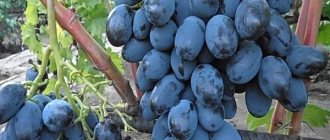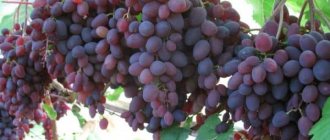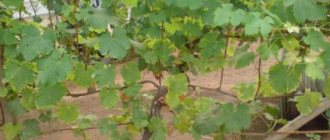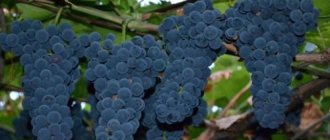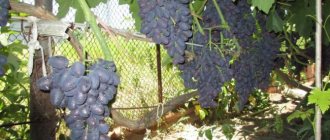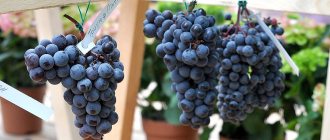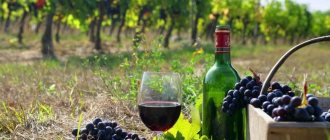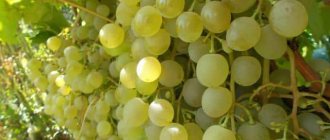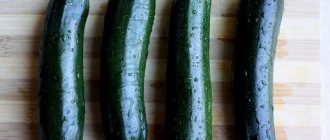Advantages and disadvantages
Pros:
- good presentation of bunches and berries;
- pleasant taste with light nutmeg notes;
- high productivity;
- does not ripple or crack;
- well stored and transported;
- high frost resistance;
- early ripening of the crop.
Minuses:
- the pulp contains small seeds;
- the vine is prone to overload;
- low pulp density;
- requires preventive treatments against fungal infections.
Pest control and disease prevention
Harold grapes are resistant to diseases such as mildew, oidium, gray rot, and powdery mildew. Nevertheless, the bushes must be treated with Bordeaux mixture (1%) or fluoride-containing fungicides before flowering.
The real danger for the Harold variety is the leaf roller, which affects all parts of the plant and causes the appearance of gray rot. To protect against the biennial leaf roller, you need to spray the bushes with insecticides twice:
- until the buds swell;
- after the buds open.
To protect grapes from grape budworm, you need to spray the bushes three times:
- in April-May;
- at the very beginning of flowering;
- at the beginning of July.
You can get rid of gray rot using a solution of laundry soap and baking soda.
You can grow Harold grapes in your summer cottage
The beautiful and tasty berries of the Harold grape variety will appeal to amateur gardeners and home cooks. Growing a vine of this variety is not too difficult; even a novice winegrower can cope with the task. At the same time, he will be able to treat the whole family with delicious berries.
The variety is well resistant to diseases such as oidium and mildew. He also almost never gets sick:
- gray mold;
- rubella;
- chlorosis;
- anthracnose;
- bacteriosis;
- bacterial cancer.
Despite this, experienced winegrowers still recommend preventive treatment of plants against these diseases.
In the spring, during the swelling of the buds, the vine is sprayed with a 1% solution of Bordeaux mixture (100 g of lime and copper sulfate are taken per 10 liters of water). You can also treat the plants with fungicides such as copper oxychloride, Strobi or Polychom.
Plants are treated against the attack of leaf rollers three times a season, in May, before flowering and in early July.
Origin
The hybrid form of the “Harold” grape was bred in Novocherkassk at the VNIIViV named after. ME AND. Potapenko. The goal of Russian breeders was to create a table grape variety with the earliest harvest ripening and high frost resistance.
“Harold’s” parents are “Delight” and “Arcadia”
To get a new hybrid, experts crossed the varieties “Delight” and “Arcadia”. The resulting transitional variant was pollinated with “summer nutmeg” pollen. The result was a new promising variety called “Harold,” which was originally called “IV-6-5-pk.”
From their parents, the grapes inherited good frost resistance, early ripening, a pleasant, harmonious taste and muscat aroma of berries.
Reference! The delicate nutmeg taste and aroma of berries is one of the main qualities thanks to which “Harold” has gained such popularity.
Despite the many advantages and love of gardeners, “Harold” is currently not included in the State Register of Breeding Achievements approved for use. And for now it remains temporarily permitted.
Harold grapes: characteristics and description of the variety, planting and care
"Harold" is a prominent representative of a frost-resistant white grape variety. The table culture was developed by breeders from Novocherkassk. As a basis for creating qualitatively new grapes, scientists used three varieties: “Arcadia”, “Summer Muscat” and “Delight”. The hybrid berry crop is popular among winegrowers, despite the fact that it is not officially included in the state register of breeding achievements. The crop can be grown in any region of Russia.
Characteristics of grapes
The grapes are ultra early ripening, 95-100 days pass from the full formation of the berries to ripening. At home, in the city of Novocherkassk, it is harvested at the end of July. In the northern regions, the berries ripen from the end of July and throughout August. Ripe grapes retain their appearance and taste on the bush for 2-3 weeks. The variety belongs to the table variety, so its main purpose is fresh consumption and processing into juice. It is processed into wine when it is overripe.
The yield from one bush, subject to proper agricultural technology, is 12-15 kilograms. The plant can withstand temperatures dropping to -24-25°C. In the southern regions it does not require shelter. In the North and Siberia, grapes can freeze, so shelters are a necessary measure for preserving the crop. Grapes have good resistance to diseases of fungal origin. Perfectly resists the attacks of oidium and mildew.
Description of grapes
The bushes grow tall and sloping, so annual pruning is required. More than half of the shoots are fruitful. 1-2 clusters are formed on the vine. The vine of an adult plant is powerful and flexible, colored light brown. The leaves are heart-shaped and medium in size. During the season, the shoots ripen to their full length.
The flowers of the berry crop are bisexual. The clusters are tied in a conical or cylindrical shape. The weight of one is 400-700 grams. The density of the brushes depends on fertilizing and watering. Most often, clusters of medium density are formed on the bushes, less often well compacted. The berries do not fall off, even if they are overripe. Their shape is oval, at the ends they may taper slightly and form a spout. The weight of one berry is 6-7 grams.
The skin is amber in color and covered with a slight waxy coating, which is almost invisible. The density of the peel is high, which protects the berries from wasp invasion and cracking. The pulp is practically not fleshy, but very juicy, colored light yellow. There are 1-3 seeds in the middle. The taste is excellent, the aroma is rich, with notes of nutmeg. The berries do not peel.
Advantages and disadvantages
We received the hybrid not so long ago, but winegrowers have already managed to fully appreciate its advantages and disadvantages. The main advantages of grapes include:
- resistance to fungal diseases;
- immunity to attacks by wasps;
- transportability over long distances;
- excellent taste;
- high productivity;
- no peas;
- at high humidity the berries do not crack;
- frost resistance;
- short ripening period.
- tendency to excessive formation of fruiting shoots, which can affect the quality of the crop;
- The berries are very attractive to birds. To preserve the fruits, it is necessary to protect the bunches with a net.
Planting and caring for grapes
A berry seedling should have 3-4 roots. Select cuttings without damage or any signs of disease. The bushes of the plant are vigorous, so place them at a distance of 2-3 meters from other grapes, trees, and shrubs. Plant "Harold" in the spring using the classic method:
- Prepare the hole for planting in the fall. Dig a hole 90 centimeters deep and 80 centimeters in diameter. Place drainage of coarse crushed stone at the bottom. Mix the extracted soil with a bucket of humus, peat and mineral fertilizers (50 grams of superphosphate and 50 grams of potassium sulfate). Pour the resulting substrate back and pour 30 liters of water.
- In the spring, dig a hole and leave a cushion of fertile soil on the drainage. Place a peg in the middle of the hole. It is necessary for tying up the plant as it grows.
- Before placing the seedling in the hole, cut off 10-15 centimeters from the length of the roots.
- Place the seedling and dig it in with earth, compacting it. Fill the soil up to the root collar. After that, pour plenty of water. Consumption per bush is 40 liters. Irrigate not only under the cuttings, but also nearby.
Caring for berry crops does not require special skills in viticulture. In order for him to grow up strong and healthy, you should adhere to simple activities.
| Event | Description |
| Watering | Water the grapes starting in April. Perform the last water-recharging irrigation in November (water consumption 70-100 liters). Watering frequency is once every 2 weeks. During the ripening period, stop irrigation. Water consumption per bush is 40 liters. |
| Mulching | To reduce moisture evaporation, mulch the area around the trunk with humus, peat, and straw. |
| Winter shelter | Cover the bushes if you live in central Russia, the North and Siberia. In the South, grapes do not freeze. |
| Form trim | Trim the bushes in autumn or spring, so that no more than 30-35 eyes remain on the bush, to avoid overload. |
| Fertilizer application | In the spring, apply nitrogen (20 g), potassium (40 g) and phosphorus (40 g) fertilizers. In the fall, add two buckets of humus under the bush. |
| Protection from diseases | Despite the high resistance of “Harold” to diseases, apply a spring treatment with one percent Bordeaux mixture. |
Reviews
Gardeners value the Harold grape for its short ripening period. There are no problems with the berry crop. As winegrowers note, the plant is not susceptible to diseases. The bushes are growing very strongly. To avoid bush thickening, gardeners recommend plucking the shoots every week.
The grapes have proven themselves to be stable and productive. Its care is standard. Fruiting is stable from year to year. The taste and aroma of the berries will pleasantly surprise even the most demanding gourmet.
Sources: https://selo.guru/sadovodstvo/vinograd/garold.html https://agrognom.ru/berries/grape/vinograd-garold.html https://ogorod-bez-hlopot.ru/vinograd-garold. html https://mirvinograda.ru/vinograd-german/
Main characteristics
The grapes of the hybrid form “Harold” have practically no disadvantages, thanks to which they have gained great popularity among winegrowers throughout Russia.
Ripening period
“Harold” belongs to the very early grape varieties. The ripening period for the berries of this hybrid is only 95-100 days from the moment the buds open. In the variety’s hometown, Novocherkassk, the harvest begins already in the third decade of July.
Bush
The grape bushes are vigorous and tend to be overloaded with harvest. Therefore, it is necessary to regularly standardize the vines and remove excess shoots and shoots.
The powerful vine is bright brown in color, very flexible, and can grow up to 8 meters. The shoots ripen along almost the entire length, 75-80%. Each bush produces up to 20 clusters of berries, with 1-2 clusters on the shoots. The stepsons also ripen, which allows for a second harvest in the fall.
The heart-shaped leaves are medium-sized, bright green. “Harold” blooms with bisexual flowers, so it does not require additional pollination.
To get a good grape harvest, it is necessary to prune and shape the bush. The most suitable for “Harold” is the fan-shaped form of the vine. It provides good lighting and ventilation of the bush, and also makes it easier to process the vine and cover it for the winter.
Bunches and berries
The “Harold” bunches are cylindrical-conical in shape, have an average size, and often weigh 400-500 grams. The berries on the clusters are located with medium density or fit tightly to each other.
Before ripening, the fruits are colored light green. Ripe berries are oval-shaped, pointed at the end, amber-yellow in color. The size of one fruit is 24x19 mm, weight 5-6 g.
The skin of the berries is quite dense, but is not noticeable when eaten. The pulp is juicy, but according to many gardeners, it is not meaty enough. In the center of the berry there are from 1 to 3 small seeds. Due to their small size, they are almost invisible when eating the fruit.
Sugar content - 19-20%. Acidity - 4-5 g/l.
Taste
The taste of “Harold” fruits is very pleasant, sweet and sour with a pronounced nutmeg aroma. The acidity and sweetness in the berries are balanced, which makes them harmonious in taste.
Productivity
Thanks to the good ripening of the vine, “Harold” has a high yield. Gardeners harvest up to 15 kg of early harvest from one bush of this hybrid.
Reference! The bushes are capable of forming stepsons that produce another harvest in the fall.
Productivity and ripening time
When planting a vineyard with its own roots or grafted seedlings, the plants bloom and produce signal clusters in the 2nd year after planting; marketable fruiting is observed from the 4th year, when one bush begins to bear an average of 14-15 kg.
In the conditions of the Rostov region, specialists obtained a yield of 15 kg from one bush in three-year-old plantings with a planting pattern of 3x1.5 m with a cup-shaped high-standard formation on a single-wire simplified trellis. During the growing season, standard agrotechnical practices were used.
In industrial plantings, “Harold” is capable of producing high yields of 16 t/ha
Removable maturity occurs 95-100 days after bud break . In the natural conditions of Novocherkassk (Rostov region), selective harvesting is carried out in late July - early August. The berries are firmly held on the stalks, do not crack or fall off. In addition, the fruits are not affected by wasps. Unfortunately, “Harold” did not inherit the unique property of the “Vostorg” variety to preserve marketability and taste without loss for a long period after ripening, so ripe fruits must be harvested without delay.
When the clusters remain on the bushes for a long time, the berries become grassy in taste and take on a “boiled” appearance.
Properly harvested fruits keep well in the refrigerator for more than 2 months. The juicy pulp is protected from damage by a dense skin, which is extremely rarely damaged during transportation, so the variety is considered promising primarily for industrial cultivation for commercial purposes.
The opinion of an experienced Ukrainian gardener about the yield potential can be found in the following video:
Comparison with analogues
Among the early ripening varieties bred in Novocherkassk, there are other hybrid forms of grapes that have qualities similar to “Harold”. Each winegrower chooses the most attractive variety for himself. And to make the choice easier, do not plant many seedlings of the same hybrid at once. Take 2-3 different ones.
| Sign | Variety | ||
| Harold | Muscat delight | Bullfinch | |
| Ripening period | 95-100 days | 110-115 days | 105-110 days |
| Frost resistance | up to -25°С | up to -27°С | up to -25°С |
| Yield per bush | up to 20 kg | up to 15 kg | up to 20 kg |
| Bunches | 0.4-0.5 kg | 0.6-0.8 kg | 0.85-1 kg |
| Taste | delicate nutmeg | harmonious, nutmeg | gentle, harmonious |
| Color | greenish, amber yellow | white, amber yellow | white-pink |
| Disease resistance | high | above average | average |
| Shelf life | up to 4 months | up to 6 months | up to 6 months |
| Sugar content | 19-20% | up to 25% | 20-23% |
| Acidity | 4-5 g/l | 5-6 g/l | 7-8 g/l |
Grapes Harold
More recently, some 50 years ago, it was believed that grapes could only be grown in the southern regions of Russia. Today, this crop bears fruit well in harsher conditions thanks to the fruitful work of breeders to create new varieties and hybrids. As an example, we can cite the Harold grape, which is distinguished not only by its taste, but also by its ability to grow and bear fruit at the latitude of the Moscow region, in Siberia.
The article will give a detailed description of the Harold grapes, characteristics of the variety, photos, reviews from gardeners and videos. Information is necessary so that gardeners can decide on the choice of crop to grow in a particular region.
History of variety selection
The white grape variety Harold is of Russian origin. The authors are Novocherkassk breeders. The following plants were chosen as parents to create a new hybrid:
So far, the Harold grape variety has not been included in the State Register of the Russian Federation, but the culture is popular among amateur winegrowers throughout Russia.
Description of grapes Harold
A description of the Harold grape variety, reviews from gardeners and photos will allow you to understand the characteristics of the culture.
The hybrid bush is tall, the light brown shoots are powerful and flexible. They have time to ripen along the entire length during the growing season. Each Harold grape vine produces up to two clusters. It is interesting that almost all shoots are fruit-bearing. This allows you to get two harvests per season. The leaves are deep green and medium in size. The shape of the leaf blade is heart.
- Flowers on the Harold variety are bisexual and therefore do not require additional pollination. The clusters have the shape of a cone or cylinder. They are quite dense. The weight of the grape bunch is between 450-700 g.
- The berries are oval with a slight point at the tip. The weight of each grape is up to 7 g, dimensions are 24x20 mm. During the ripening period, the bunch becomes amber, the berries glow in the sun. Although there is a waxy coating, it is insignificant.
- Berries with thick skin. This saves the bunches from cracking and wasp invasion. Sweet berries have fleshy and juicy pulp of light yellow color. Each grape contains no more than 3 seeds. The taste is subtle, with a hint of nutmeg.
The Harold grape variety has taken root in the Moscow region and in the Siberian regions.
Characteristics of the variety
To understand the characteristics of any grape variety, one description is not enough. You need to know the characteristics. Gardeners are interested in the plant’s attitude to drought, frost, the yield of the variety, as well as the commercial quality of the berries.
Drought resistance, frost resistance
Harold grapes are a drought- and frost-resistant plant, which is why the grapes are recommended for growing in the harsh conditions of Siberia. It can withstand temperatures down to -25 degrees.
Harold grapes, according to reviews from gardeners in the Moscow region, do not need major shelter; it is enough to cover the plantings with spruce branches. As for Siberia, to preserve the vines it is necessary to cover the plants with covering material.
Productivity and fruiting
Harold grape variety is early ripening. The berries ripen 100 days after the cluster forms. As a rule, this occurs in late July - early August, depending on the growing region. The berries do not fall off and do not lose their presentation, hanging on the vine for up to 3 weeks.
From one grape bush, up to 15 kg of delicious berries with a muscat aroma are harvested per season, if the conditions of agricultural technology are met. In the south, gardeners harvest the Harold variety twice, since some of the clusters will form on the stepsons.
Adverse weather conditions have virtually no effect on the yield, but failure to follow the rules of care can reduce the number of brushes.
Area of application of fruits
The purpose of table grapes of the Harold variety is universal. The berries are delicious fresh and processed. Gardeners make juice and compote at home. Wine with muscat notes is also tasty.
Resistance to diseases and pests
Plants practically do not suffer from mildew, gray rot, or oidium. Wasps are not afraid of Harold grapes, since they cannot pierce the dense skin of the berries with their sting.
Advantages and disadvantages of the variety
Despite the fact that the Harold variety is relatively young, it is popular among gardeners in the Moscow region and Siberia due to its advantages:
- early ripening, which is very important during the short Siberian summer;
- high yields even under unfavorable climatic conditions;
- resistance to many grape diseases;
- impossibility of damage by wasps;
- excellent transportability and long-lasting shelf life;
- preservation of berries on the vine even if overripe;
- excellent taste quality;
- the ability to form clusters of medium density without peas;
- drought and frost resistance.
Among the disadvantages of Harold grapes, gardeners note in reviews:
- high formation of shoots, so they need to be constantly rationed;
- the need to shelter bunches of the Harold variety from bird invasion.
Rules for planting Harold grapes
The further development of the plant and obtaining a decent harvest depend on whether the vine is chosen correctly and measures are taken to plant the grapes in a permanent place. When planting, it should be taken into account that the Harold grape variety grows greatly. That is why there should be at least 2.5 m between plants. Grapevines are planted in separate holes or trenches, depending on the size of the area.
Recommended timing
As experienced gardeners write in reviews, it is advisable to plant the Harold grape variety in the spring from April 20 to the end of May. Later dates are not suitable due to poor rooting. The main condition for planting vines is warming the soil at a depth of 20 cm to 10 degrees. Over the summer, the vine will have time to ripen, so it will not freeze in winter.
Choosing a suitable location
Harold grapes, according to the description of the variety and the attached photos, can grow anywhere and on any soil. But the yield will be low. Therefore, it is best to allocate the southern or southwestern part of the site for a plantation.
The crop ripens well in soils with neutral acidity. The soil should be well fertilized, light and moisture-permeable.
Planting Harold grapes is not allowed where groundwater lies close to the surface. If there is no other possibility, then an artificial elevation with good drainage is made.
Selection and preparation of planting material
You can get a fruit-bearing grape plantation only if you have healthy planting material. The selection of seedlings needs to be given special attention.
Quality Harold grape seedlings have:
- Available from 4 roots, they must be long and thick;
- the root system should be free of damage, signs of disease, and most importantly, rot;
- The selected Harold grape seedlings, according to the description and photo below, should have a flexible light brown vine that has matured along its entire length.
Landing algorithm
Planting Harold grapes is no different from other varieties:
- The pit is prepared in the fall so that the soil has time to settle.
- The dimensions of the seat must correspond to the root system of the seedling.
- As a rule, a hole is dug to a depth of 80 cm, and the diameter is the same.
- A drainage consisting of small stones is poured into the bottom of the hole.
- Then potassium salt and superphosphate are added, mixed with soil.
- The remaining volume is filled with nutrient soil and filled with water.
- Before planting, part of the soil is removed to accommodate the root of the grapevine.
- Before planting, the seedling is kept in a growth stimulator or dipped in a clay mash, the root system is shortened by a third, and non-living parts are removed.
- The shoots are shortened to 5 eyes.
- When planting, the seedling is placed on its heel and sprinkled with soil.
- A peg is installed in the middle to which the vine is fixed.
- After planting, trample the soil to remove air and water well.
- At least two buckets of water are poured under each plant.
Aftercare for grapes
Harold grapes are unpretentious in care, which is what attracts gardeners. You just need to follow the agrotechnical rules in a timely manner.
- The grape plantation should be watered from April, immediately after buds open, until October, only with warm water.
- For each bush up to 5 buckets of water.
- When the Harold grapes begin to bloom, stop watering, otherwise the ovaries will fall off.
- In the spring and before covering the grapes for the winter, moisture-recharging irrigation is carried out. Up to 7 buckets of water are poured under one plant.
Mulching. It is recommended to sprinkle the tree trunk circle with mulch. Can be used:
- humus;
- peat;
- leaves;
- grass clippings without seeds.
Feeding. If the soil was well fertilized when planting, then you don’t have to worry about fertilizing for 4 years. In the future, adult plants are fed with mineral fertilizers every year:
Organic matter in the form of chicken manure and mullein must be added every two years.
To prevent rodents, shoots can be wrapped in non-woven material.
Grape pruning
Pruning Harold grapes is necessary for the correct formation of the bush. The vine takes this operation calmly; it is not afraid of even severe pruning.
No more than 35 eyes are left on young shoots, and up to 20 on stepchildren. This pruning helps reduce the load on the bush.
Many gardeners remove the inflorescences on the stepsons of the Harold variety that appear before the end of June. Later flowers are left for a second harvest of berries.
Protecting crops from birds and insects
Not only people like the sweet berries of the Harold variety. If wasps are not able to bite through the skin of the fruits, then the plants will have to be covered from birds with a net or each bunch will have to be “packed” in special bags.
Preparing the crop for winter
In the Southern regions, the vine is not covered. In the Moscow region and Siberia you will have to do a little work:
- After pruning, the vine is removed from the support and carefully laid on the ground.
- To prevent the stems from rising, they are pinned with staples.
- Coniferous spruce branches are placed on top and covered with any material.
Methods of propagation of grapes
The Harold variety is propagated by cuttings. Prepare the material in the fall:
- Cuttings are cut from a well-ripened vine, wrapped in cellophane and stored in the refrigerator on the bottom shelf.
- In February, the cuttings are placed in water and the jar is kept in a sunny window.
- After a while, roots will appear.
- When the root system develops, the cuttings are transplanted into moist soil.
- They are transplanted to a permanent place with the onset of warm weather.
Diseases and pests, methods of control and prevention
Although Harold grapes are resistant to many crop diseases and pests, prevention does not hurt.
What do we have to do:
- Spray the plantings and the soil underneath them with a one percent solution of Bordeaux mixture or any fungicides containing phosphorus.
- You can also use a one percent solution of boric acid. This treatment will rid the grape plantation of gray rot.
- For 10 liters of water you will need 100 g of soda and 40 g of laundry soap. The last component is necessary for the adhesion of the liquid.
Conclusion
Harold grapes are an unpretentious plant that a novice gardener can handle. Of course, when growing a crop for the first time, many questions and difficulties will arise. Therefore, you will need to watch various instructive videos about Harold grapes:
Useful properties and scope of use
Harold grapes contain a large amount of vitamins, fruit acids and various microelements. Its benefits for the human body are undeniable. With regular, moderate consumption of grapes, you can improve your health, overall well-being and mood. It has a positive effect on the cardiovascular system; helps fight migraines; lowers blood pressure; helps in the fight against stress.
| Benefits of grapes | ||
| For men | For women | For children |
| Normalizes blood cholesterol levels and improves liver function | Prevents premature cell aging | Has antimicrobial, antifungal and healing effects |
| Helps normalize blood pressure | Improves digestion, normalizes the metabolism of proteins, fats and carbohydrates | Improves memory properties |
| Reduces the risk of developing atherosclerosis and cancer cells | Helps fight bronchopulmonary, cardiovascular diseases and pathologies of the urinary system | Helps improve vision |
| Prevents strokes and heart attacks | Rejuvenates, cleanses the body of waste and toxins | Boosts immunity |
Important! Grapes should be consumed with caution by people suffering from excess weight and diabetes. The berries contain a lot of sugars and have a high calorie content - about 65 kcal per 100 grams of fruit.
Gardeners who grew the Harold crop noted its excellent taste. The berries are consumed fresh or used to make juices, compotes, and jams. The noble Muscat taste and aroma of the fruit attract winemakers to this grape, who produce excellent homemade wines that are close to elite ones.
How to care for the Harold variety
Good care of grapes will provide the farmer with a rich and tasty harvest of these unusual berries. There are several features of caring for the Harold variety: you need to know how to water and feed it, how to trim and tie up bushes, how to cover it for the winter and protect it from pests.
Watering and fertilizing
During the season, Harold needs 4 waterings:
- in spring after flowering ends;
- when the berries begin to ripen;
- after harvest;
- before sheltering for the winter.
5 buckets of water are poured under the bush. Before sheltering for the winter, each bush will need more moisture - 6-7 buckets.
In the third or fourth year after planting, Harold grapes need to be fertilized: 2-3 times during spring and summer. The soil under the bushes is fed with nitrogen, potassium and phosphorus fertilizers.
You need to prepare a solution: superphosphate, ammonium nitrate and potassium salt are dissolved in 10 liters of water in a ratio of 2: 1: 0.5. Organic fertilizers are required every 2–3 years.
Bush formation and pruning
Large and spreading grape bushes need to be pruned regularly. It is advisable to form a bush according to a fan pattern. This is great for growing in cool climates that require covering the bushes for the winter.
If the climate is warm and shelter is not needed, then the bushes are formed in standard form. One or two main vines are suspended vertically by 2–3 m, and the remaining shoots are fixed on horizontal supports.
Important! Every year you need to prune Harold's shoots, leaving 25-30 nodes on each bush.
Stepchildren are useful only in warm climates: they can produce a second harvest in mid-September or October. There should be no more than 20 inflorescences on 1 stepson. In cold climates, stepchildren do not bear fruit, but only take nutrients from the plant, so they should be removed.
Garter
Tall seedlings can be carefully tied to a support immediately after planting. In standard forming, the main shoots are tied to vertical supports, and additional shoots to horizontal ones. When fanning, several vertical supports are often required, to which each branch is tied.
Shelter for the winter
Harold grapes need shelter to protect them from the harsh winter. The bushes are removed from the support, tied, laid on the ground and attached to it.
Then metal arcs are installed above them, plastic film is placed on them and the grape bushes are covered. One layer of polyethylene is enough.
Features of cultivation
“Harold” is quite unpretentious, but to obtain a bountiful harvest it is necessary to follow some agricultural practices.
This is the kind of harvest “Harold” can produce
Boarding time
“Harold” is planted both in spring and autumn. The optimal planting time is spring, late April - mid-May. In this case, during the season the grape seedling will have time to take root and gain the nutrients necessary for a successful winter.
Place and soil
This hybrid does not have any special requirements for the composition of the soil. As with other grape varieties, light, fertile soils with a high chernozem content and providing good water and air exchange are most suitable for it. On soils rich in nutrients, grapes will produce the most voluminous harvest.
Important! If groundwater is close to the soil surface, a drainage layer must be added to the planting hole.
If your site is located in a lowland, it is recommended to create an artificial hill so that the bushes are illuminated by sunlight as much as possible and for as long as possible. The place for the vineyard should be well lit and ventilated.
According to gardeners, “Harold” takes root better when planted with seedlings rather than cuttings. You should also pay attention to planting material and do not purchase seedlings that have mechanical damage or signs of disease. More details on seedling diseases in a separate article.
Watering and fertilizing
During the season, “Harold” needs 4 waterings with warm, settled water:
- 7-10 days before flowering begins.
- During the formation of berries.
- After the harvest.
- Before winter shelter.
Important! During flowering and ripening of berries, watering should be avoided. In the first case, the buds may fall off, in the second, excess moisture often leads to cracking.
“Harold” tolerates temporary drought well, but in order for the soil to better retain moisture, it is recommended to mulch it. The following mulch is used: sawdust, straw, humus, spruce branches, film or spunbond.
Grape bushes begin to need fertilizing from the third year after planting, because... All the substances necessary for young plants were placed in the planting pit. 2-3 times per season, “Harold” is fertilized with nitrogen, phosphorus and potassium fertilizers dissolved in water. The first feeding is carried out in early spring, before the buds swell. Subsequent ones - before and after flowering.
At intervals of 3 years, organic matter is added to the bushes. As organic fertilizers you can use: rotted manure, compost or bird droppings.
Trimming
In regions with a warm climate, where grapes are grown uncovered, pruning of “Harold” in a high-bole form is allowed. In the cooler central and Siberian regions, fan formation of the bush is used for this variety.
Every year in the fall the vine is pruned, leaving up to 30 buds on it. To prevent the bush from being overloaded with the harvest, the ovaries must be rationed after flowering. There should be no more than 20 brushes on 1 bush. This technique will allow you not to overload the vine and will make it possible to get a second harvest in the fall.
In the spring, after removing the cover, shoots damaged during the winter are removed. In the summer, green pruning is carried out: excess young shoots and shoots are cut off. This will avoid excessive thickening of the bush.
Diseases and pests
“Harold” has a fairly high immunity to fungal diseases. Its resistance to mildew is estimated at 3.0 points, and to oidium - 3.5 points. This variety also resists gray rot well.
Reference! Despite its high resistance, “Harold” still needs preventive spraying. It is carried out before the grapes bloom using Bordeaux mixture or other fungicide formulations.
This hybrid of spider mites and wasps is not afraid. The danger comes from birds that are not averse to eating the sweet harvest. To protect the berries from bird hunters, the bushes are covered with fine mesh. If the vineyard is not very large, you can put a nylon net on each bunch.
Option for sheltering grapes from birds and wasps
A particular problem in growing “Harold” is the leaf roller. This insect harms inflorescences, young shoots, ovaries and grape berries. To protect the vineyard from this pest, you need to spray the plants with an insecticide solution twice a season. The first time the treatment is carried out in early spring on the bare vine and sprayed again after the leaves bloom.
Shelter for the winter
Harold grapes have good resistance to frost and can withstand temperatures down to -25°C. However, in the cold northern regions of Russia, where winters are more severe and the air temperature often drops below the maximum permissible level, the vine must be covered during cold weather.
In the autumn, after the leaves have fallen, water-charging irrigation is carried out (about 20 liters of water per 1 bush). The vine is removed from the trellis, tied and laid on the ground along the row, secured with staples to the ground. It is best to install small arcs over the bushes so that the protection does not come into contact with the shoots. A plastic film is attached to the arcs, which serves to protect the vines from frost. They are also covered with spunbond, pine needles, straw, or simply covered with earth.
Harvest storage
Ripe bunches of “Harold” are perfectly stored on the bushes for up to 2 months.
Without shedding or loss of moisture, they can hang on the vine until mid-September. Also, this variety tolerates long-term transportation well and has a fairly long shelf life, without loss of presentation.
Bunches of grapes hung in a cool, dry room can be stored for up to 4 months.
Cultivation regions
Thanks to very good frost resistance, growing Harold grapes is available to all gardeners in Russia. From the southern regions to the Moscow region, the Urals and Siberia, amateur winegrowers can harvest abundant harvests of this variety and surprise guests with their own early sunny berries, which are usually grown in warm climates.
The only thing gardeners living in cold climates should remember is covering the vines for the winter.
A variety that deserves a place on every site - ultra-early Harold
Until relatively recently, gardeners in temperate and northern latitudes could only sigh sadly at the word “vineyard.”
And indeed: many varieties, even seemingly unpretentious ones, are afraid of cold and frost. Breeders have found a way to please northern farmers.
Harold grapes easily tolerate low temperatures, and do not require too much complex care.
What type does it belong to?
Harold is a hybrid form of white table grape. Ripening period is super early . It ripens in about a hundred days, so the harvest can be harvested already at the end of July or beginning of August, but lovers of homemade wine usually leave it hanging until September so that there is more sugar.
Among the white hybrid varieties, Timur, Bazhena and Muscat Vostorg stand out.
The berries retain their presentation and taste even during long-term storage or transportation, and do not crack or deteriorate.
Grapes Harold: description of the variety
The bush is very vigorous. The bunch has a cylindrical-cone shape, dense, without peas, average weight - 500-600 g.
Julian, Lancelot and Zagrava are also not prone to peas.
Flowers are hermaphrodites. The berries are elongated, with a pointed tip, moon-amber in color, above average in size (average weight 6 g). The skin is dense, of medium thickness.
The pulp is juicy, dense, not very fleshy, but very sweet and with a rich aftertaste (nutmeg and strawberry notes).
The vine is bright brown, powerful, flexible. The leaves are bright green, medium-sized, heart-shaped. Young shoots are light green, mature shoots are brown with reddish nodules.
See photos of Harold grapes below:
History of selection
It was obtained as a result of crossing a hybrid of the Arcadia and Vostorg varieties with the Summer Muscat variety at VNIIViV named after. Potapenko (Novocherkassk).
In areas with warm and mild climates it is most popular, since the question of shelter is not even raised. According to the breeders, the Siberian and Ural territories are also quite suitable for Harold, however, the frost resistance of this variety is currently being tested.
Among the extremely frost-resistant varieties, Super Extra, Krasa Severa and Tukai stand out.
Characteristics
According to preliminary data, the variety is frost-resistant down to -25-26 degrees. It is also not afraid of wasps, gray mold, ticks, powdery mildew (oidium and mildew). The shoots ripen to almost their entire length.
It has a rich, rich taste with an unobtrusive nutmeg note. The Harold variety is very prolific - it produces up to 15 kilos of berries per bush.
It is not picky about soil conditions - it tolerates both mild drought and moisture. The sugar level is good - about 20%, acidity - about 5 g / cubic dm. According to some farmers , Harold grapes are afraid of spring frosts, and in latitudes with noticeable “minuses” they require mandatory shelter. Requires standard watering - from April to October.
Useful video
Useful video about the characteristics of the Harold grape variety:
Diseases and pests
The resistance of this variety to gray rot and powdery mildew is good, but still not so much as to neglect prevention. The same applies to diseases such as bacteriosis, anthracnose, chlorosis, rubella and bacterial cancer. Notified means armed. By knowing the signs and methods of prevention, you can protect your plants.
To do this, it is recommended to spray the bush before flowering with phosphorus-containing fungicides or a one percent solution of Bordeaux mixture.
wasps and spider mites , but he is not afraid of birds. A reinforced barrier mesh will save you from annoying magpies and sparrows.
We will have to take measures to combat the cluster leaf roller - Harold, unfortunately, is one of its “favorites”. Moreover, this applies to both the cluster and biennial leafrollers.
If measures are not taken, it will spoil everything it sees, and these are inflorescences, young shoots, ovaries, and berries. But it must be said that a berry “tasted” by the leaf roller will immediately become a “target” for gray rot.
It is good to use insecticides against leaf rollers: Karate-zeon, BI-58, Kinmiks, Arrivo, Benzophosphate, Sumi-Alpha, Apollo, Karbotsin, Talstar, Zolon, Anometrine, Sherpa.
As for bunchweed , it is sprayed in three stages. The first is 2 weeks after the first generation butterflies start flying (April-May). The second is the very beginning of flowering. The third - ten to fifteen days after the second generation has flown (late June - early July).
The grape leaf roller can be limed by spraying the vineyard in two stages. The first occurs at the beginning of the swelling of the buds, the second - after they bloom.
Harold grapes are an excellent choice for farmers in southern and central Russia. Where “real Russian winters” are felt, the bush must be covered for the winter. It will delight you with an abundant and regular harvest, you just need not to be lazy, protect it from frost and enemies, such as birds and caterpillars.
If you find an error, please select a piece of text and press Ctrl+Enter.
Photo
Next, check out the photos and reviews about the “Harold” variety.
Reviews
It has one extremely undeniable advantage - it is a real, very early ripening period. Many people like the taste - bright nutmeg. The pulp, in my opinion, could have been meatier. Svetlana, Novocherkassk
Harold's berries have never burst or fallen off, and he tolerates transportation well. Vladimir, Kyiv


